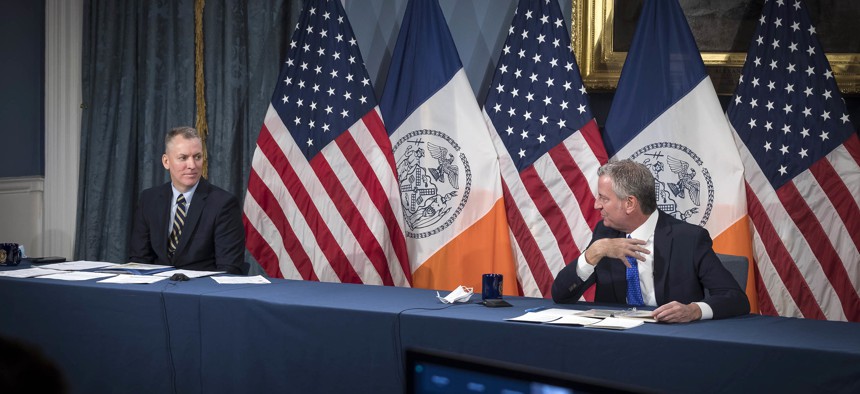New York City Mayor Bill de Blasio, in his final crime briefing before he leaves office at the end of the month, presented a bleak picture on Wednesday of surging murders, robberies and hate crimes, along with staggering crime increases in the city’s transit system and public housing complexes.
Despite the troubling statistics, de Blasio lauded New York City Police Department Commissioner Dermot Shea, who recently filed for retirement, and insisted New York is still “the safest big city in America” – a term coined by his predecessor former Mayor Michael Bloomberg as he left office at the end of 2013.
“I think Commissioner Shea will be remembered for helping to see us through COVID, for taking on one of the greatest challenges any police leader has had,” de Blasio said. “We are … as we have been for a long, long time, the safest big city in America.”
Through Dec. 5, murders rose 1.4% this year compared to the same time frame last year, and are up 700% for the week of Nov. 29 through Dec. 5, when the NYPD recorded eight homicides compared to just one during that week in 2020, statistics released on Wednesday show.
Over the past two years, murders have ticked up 45%.
All but one of the seven serious index crimes, which include murder, rape, robbery, felony assault, burglary, grand larceny and car theft, have increased this year, the data shows. Burglaries are down 19.5%.
A total of 479 hate crimes for the year represent a staggering 93% increase from the number recorded through Dec. 5, 2020.
Transit crime is also up 104% for the 28-day period ending Dec. 5, but down 2.8% for the year.
Housing crime has ticked up 7% this year versus 2020, a rise Shea attributed to an increase in felony assaults and domestic violence during the Wednesday briefing.
The 4.5% uptick in robberies this year, Shea said, are due to shoplifting sprees that have been taking place across the country.
“It’s probably one of the easiest crimes to stop between store security, between officers responding. The problem is that when they’re arrested, we're literally letting them go,” Shea said, referring to bail reforms that require most defendants accused of non-violent crimes to be released without bail.
Recidivism is also behind some of the more serious crime waves in the city, Shea said, noting that “the people that we are seeing currently being arrested for shootings, 30% or most have an open felony case. These are indicators of challenges ahead that we kind of have to hone in and make improvements on.”
Separately, he also noted a rise in gun crimes among defendants under the age of 18. Ten percent of youth arrests are for a firearm, Shea said, compared to 1.8% just a year ago.
“That is a jump up, so (while) we see a lot of good news, a lot of improvement that we’ve made, we know we have a lot of work to do,” he said
The briefing marks the end of the chaotic de Blasio-Shea era marked by a surge in shootings during the pandemic, protests marred by incidents of police brutality and a staffing shortage in the NYPD due to the pandemic, along with a wave of resignations and retirements.
Though de Blasio spent the majority of the press conference boosting the commissioner and his own record on crime, he acknowledged room for improvement.
“I made mistakes, I’ve talked about them. I’m sure the commissioner can say where he wishes he had done things differently,” de Blasio said.


